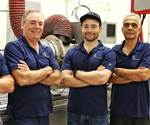Velo3D, Boom Supersonic Partner to 3D Print Metal Supersonic Jet Parts
Velo3D has announced its partnership with Boom Supersonic to print the first 3D metal parts on Boom’s XB-1 Mach-2.2 supersonic demonstrator aircraft.
Velo3D has partnered with Boom Supersonic, the company building what is said to be the fastest supersonic airliner, to manufacture the flight hardware necessary to build XB-1, Boom’s Mach-2.2 supersonic demonstrator aircraft. Boom is leveraging Velo3D’s Intelligent Fusion technology, which enables significant process control that helps make impossible designs a reality.
According to the company, XB-1 is the first independently-developed supersonic jet that will prove the key technologies in-flight for safe, efficient travel at Mach 2.2 (1,687 m/hr.). XB-1 combines over 3,700 parts as well as advanced technologies including advanced carbon fiber composites, a refined delta wing planform and an efficient variable-geometry propulsion system.
XB-1 has demanding functional, performance and precision requirements. Velo3D’s Intelligent Fusion technology provides control, design freedom and quality assurance that in challenging design environments such as supersonic aircraft performance. With Velo3D, Boom says its company aims to use metal additive manufacturing to accelerate aircraft development and improve system performance.
“High-speed air travel relies on technology that is proven to be safe, reliable and efficient.” says Mike Jagemann, head of XB-1 production, Boom Supersonic. “Velo3D helped us understand the capabilities and limitations of metal additive manufacturing and the positive impact it would potentially have on our supersonic aircraft.”
Boom and Velo3D have already conducted validation trials to desired results. Now, Velo3D is developing two titanium flight hardware parts for XB-1, which will be installed on the prototype aircraft in early 2020. These 3D-printed parts are installed as part of the ECS system and ensure the aircraft can achieve safe flight at all conditions.
“Boom is re-imagining the entire commercial aircraft experience, from the design, build and materials used,” says Benny Buller, CEO of Velo3D. “Our technology is designed to help innovators like Boom rethink what’s possible, empower advanced designs with little or no postprocessing, and enable an entirely new approach to production. Boom needed more than just prototypes and we’re thrilled to help them create the first 3D-printed metal parts for an aircraft that will move faster than the speed of sound.”
Related Content
-
3D Printed Titanium Replaces Aluminum for Unmanned Aircraft Wing Splice: The Cool Parts Show #72
Rapid Plasma Deposition produces the near-net-shape preform for a newly designed wing splice for remotely piloted aircraft from General Atomics. The Cool Parts Show visits Norsk Titanium, where this part is made.
-
Additive Manufacturing in Space: Failing Upward
Not all 3D printed parts destined for space need to adhere to the standards of human space flight. Yet all parts made for space programs require some type of qualification and certification. NASA and The Barnes Global Advisors explore Q&C for these parts.
-
3D Printed NASA Thrust Chamber Assembly Combines Two Metal Processes: The Cool Parts Show #71
Laser powder bed fusion and directed energy deposition combine for an integrated multimetal rocket propulsion system that will save cost and time for NASA. The Cool Parts Show visits NASA’s Marshall Space Flight Center.














